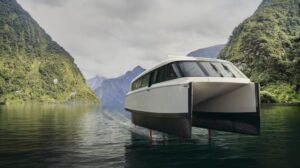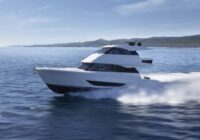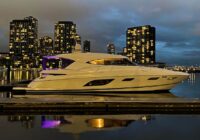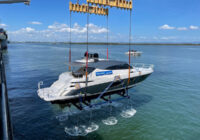New Zealand’s most beautiful lake is about to get a high-tech upgrade, with Meridian Energy set to bring the world’s first electric hydrofoiling ferry to Lake Manapōuri – Candela P-12.

The new, Swedish-made Candela P-12 electric hydrofoil ferry will provide daily transport for the staff and contractors servicing the country’s largest hydro power station, Manapōuri Power Station. It’ll save 240 tons of carbon emissions each year – equivalent to taking 52 petrol cars off the road.
Tania Palmer, Meridian’s GM of Generation, says it’s one way the company is reducing its emissions from internal transport, contributing to Meridian’s goal of halving its emissions by 2030.
“We have to be bold and innovative to reduce emissions. This deal is the result of a global search to identify the latest and best technology for our needs, and one that’s suitable for such an incredible natural environment.”
“The Candela P-12 is an exciting replacement for the diesel ferry we currently use to transport people across the lake to the power station. It’ll drastically reduce emissions and, at the same time, give our team what’s arguably the best and most spectacular commute in the world.”
Meridian has signed a deal with Swedish company Candela to provide the P-12 and will be the first customer outside Europe to take delivery of the electric shuttle ferry, which has been described as a game changer for waterborne transport.
Flying on computer-guided hydrofoils, the P-12’s hull rises above the water at high speed, which reduces energy consumption by a staggering 80% when compared to traditional vessels, and allows for long range and high-speed travel using battery power only. Boasting the highest top speed and longest range of any electric ferry, it also provides many environmental benefits. At a cruise speed of 25 knots, the wake behind the vessel is less than 15cm high, which will minimize disruption to the shoreline of Lake Manapōuri – part of a UNESCO World Heritage Area and home to many indigenous species, including longfin eel.
As the ferry flies over Lake Manapōuri, which has been voted the country’s most beautiful lake, its passengers need not worry about getting seasick; the P-12 is stabilized in real-time by a computer system —a Flight controller which prevents the motion-sickness inducing pitching and slamming found in other ships. The Flight controller uses sensors to measure the wave height in front of the vessel, and then adjusts the hydrofoils’ angle of attack 100 times per second to provide a smooth ride over them.
“We’re excited to partner with a global leader in the transition to sustainable energy and global decarbonisation and thrilled to soon see our P-12 in action on Lake Manapōuri,” says Gustav Hasselskog, Candela CEO.
“We thank Meridian for leading the charge towards a cleaner, greener future.”
The Candela P-12 is expected to begin operating on Lake Manapouri in 2025.
Quick facts about the Candela P-12 ferry
Candela is a Swedish tech company dedicated to unlocking the potential of our waterways for sustainable transport. Candela designs and builds the world’s first electric hydrofoil ships and boats. As these vessels fly above the friction of water, they overcome the greatest hurdle to electrification at sea, namely that conventional hulls are hugely inefficient and have correspondingly short range at high speeds.
After launching the best-selling C-8 leisure boat in 2019 Candela is now set to revolutionize commuting with the record-shattering P-12 ferry, which was launched three months ago.
Candela P-12:
- The fastest electric ferry in the world, with a 30-knot top speed
- Has the longest range of any electric ship with a range of 50 nautical miles at 25 knots
- 80% lower energy consumption than conventional vessels, making it the most efficient fast ship to date
- Minimal wake generation, which can cut travel times drastically, given exemptions from speed limits (as in Stockholm).
- 90% lower energy/maintenance costs than diesel vessels, allowing operators to transition from diesel ships to sustainable fleets and making a profit
- Requires very low investments for charging infrastructure, thanks to its high efficiency. A typical DC charger for cars is sufficient
Stats
- Length 12 meters
- Beam 4.5 meters
- Capacity 30 passengers, seated
- Battery 254 kWh
- Motors 2 x Candela C-POD
- Top speed 30 knots
- Cruise speed 25 knots
- Range 50 nautical miles at 25 knots








